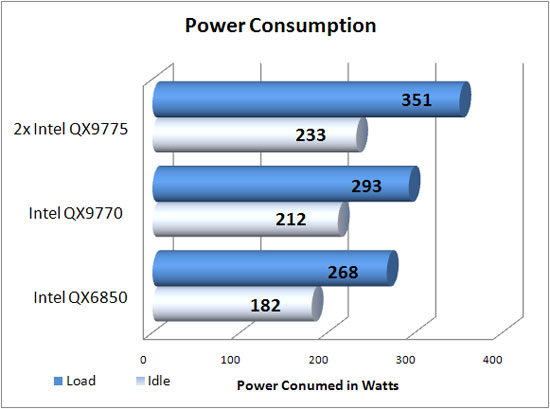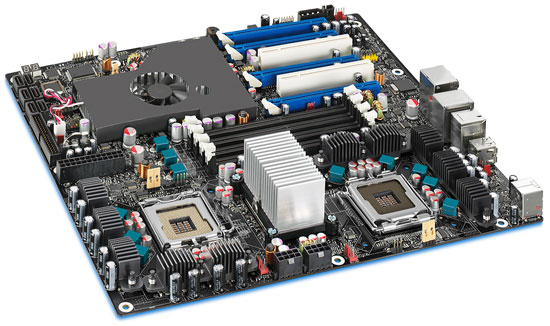Intel SkullTrail Preview – Dual Core 2 Extreme QX9775 Processors
Power Consumption and Final Thoughts
Power Consumption
Since power consumption is a big deal these days, we ran some simple power consumption tests on our test beds. The systems ran with the power supplies, case fan, video card and hard drive model. To measure idle usage, we ran the system at idle for one hour on the desktop with no screen saver and took the measurement. For load measurements POV-Ray 3.7 was run on all cores to make sure each and every processor was at 100% load. All of the systems used identical hardware minus the motherboard and processor.

Results: No shocker here as Skulltrail consumes more power than the rest, but it is no where near the recommended power supplies that Intel listed. Even when running a pair of GeForce 8800 GTS 512MB video cards in SLI on Call of Duty 4 v1.5 the system peaked at just 445W.

Final Thoughts
When it comes to performance, the Intel Skulltrail platform is hands down the fastest platform that we have ever looked at. With the dual 3.2GHz Core 2 Extreme QX9775 quad-core processors in the system, it consistently outperformed the other test systems in multi-threaded tests that could take advantage of the eight cores. The only two areas that the Skulltrail platform didn’t shine was in memory bandwidth and gaming. The DDR2-800 FB-DIMMs just don’t provide the memory bandwidth needed to compete with DDR3 memory kits and it shows where memory bandwidth does come into play. When it comes to gaming, it’s not the fact the board is only PCI Express 1.0, it is because the games are not optimized to run on eight cores. In reality, many games are designed to run on just three cores as many games are now written with consoles in mind.
The Intel D5400XS motherboard was very easy to use and proved to be a solid platform to pound on. The fact that it can do both SLI and CrossFire is impressive and even more so when you consider the fact that CrossFire is running on the NVIDIA nForce 100 controllers. It is obvious that multi-gpu technology is here to stay and this board is nice that it supports both video card companies. Our only gripe with the Intel D5400XS motherboard is the fan on the low-profile heat sink. That sucker is really loud and if things are getting that hot maybe a different heat sink material or heat-pipes could be used to get away from the loud fan.
When it comes to pricing, Intel has not said anything as of yet other than thet the QX9775 CPU MSRP will be announced at launch in Q1. This will be a Core 2 Extreme branded part with even higher specs than standard Extremes, and Intel has acknowledged that it will be priced higher than the current shipping QX9650 Core 2 Extreme part. The Intel Core 2 Extreme QX9650 Quad-Core Processor sells for $1049.98 online, so expect the QX9775 to be over that. Keep in mind that other LGA771 Xeon processors will also work in the Skulltrail board, providing the DIY customer or OEM other configuration options for other price points if the QX9775 costs too much. Remember, Skulltrail is the codename for the Intel D5400XS board, and the platform includes both board and the QX9775 CPU. The Intel D5499XS motherboard will also launch sometime in Q1 and again no price is given. This is an extreme enthusiast board typically seen in high end workstations to give you an idea of the price range ballpark you can consider. These parts aren’t cheap, but the level of performance they offer is like no other. If you make a living doing video editing with software like Sony Vegas 8.0B, then the price might just be worth the time saved! Too bad AMD killed the QuadFX series as it would have been nice to see a pair of Phenoms try to compete with this beast!
Legit Bottom Line: Skulltrail was rightly named as it came out just after AMD killed the QuadFX enthusiast series and it continues the V8 legacy by being the fastest platform on the planet!

Comments are closed.